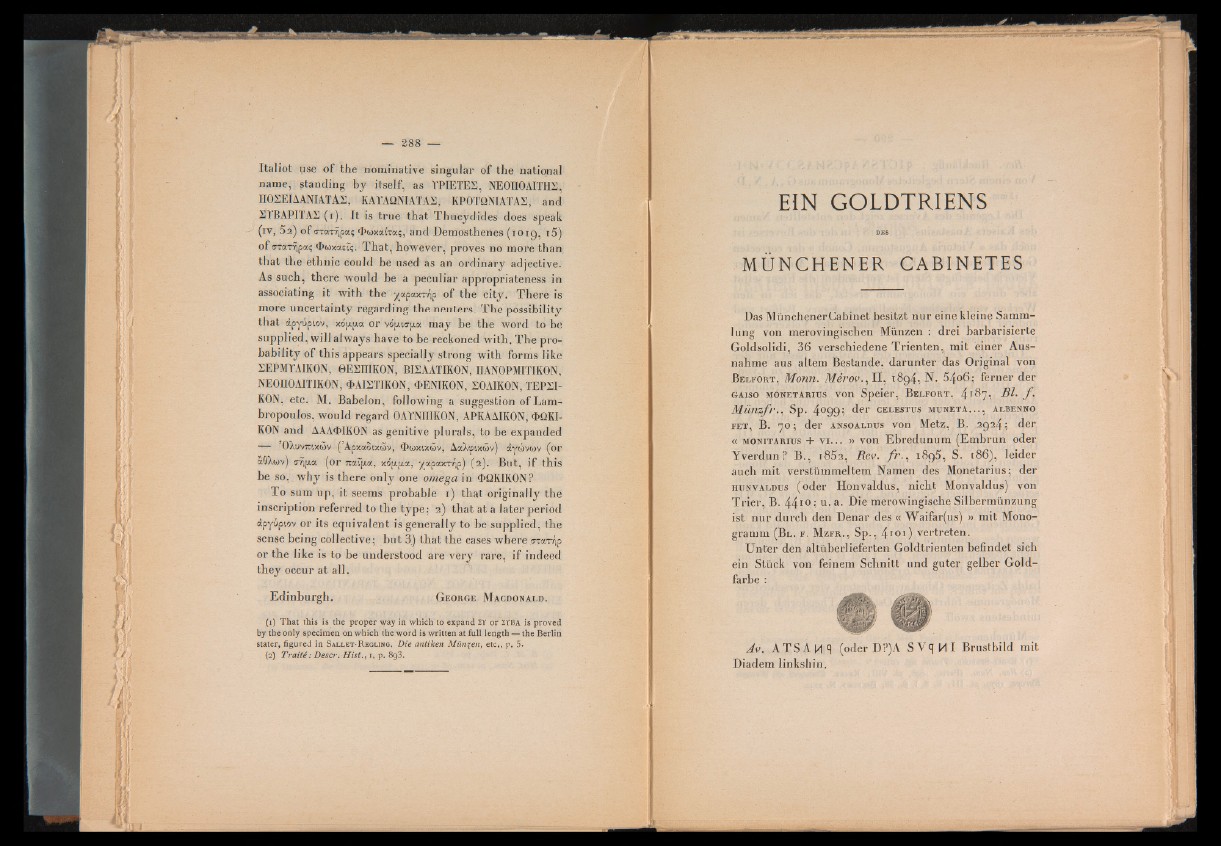
Italiot use of the nominative singular of the national
name, standing by itself, as TPIETES, NE0II0AITH2 ,
BOEEIAANIATAS, KAYAQNIATAS, KPOTQNIATAE, and
EYBAPITAE (x). It is true that Thucydides does speak
(iv, 5a) of d T a T ^ p a ç <Ï>w x o u t <xi; , and Demosthenes (1019, i 5)
of onmjpa? «bwxasîç. That, however, proves no more than
that the ethnic could be used as an ordinary adjective.
As such, there would be a peculiar appropriateness in
associating it with the yapaxT7,p of the city. There is
more uncertainty regarding the neuters. The possibility
that dpyuptov, xoppa or vofnapa may be the word to be
supplied, will always have to be reckoned with. The probability
of this appears specially strong with forms like
2EPMYAIK0N, 0E2ÜIKON, BIEAATIKON, IIANOPMITIKON,
NEOnOAITlKON, «MISTIKON, «PENIKON, EOAIKON, TEP2I-
KON, etc. M. Babelon, following a suggestion of Lam-
bropoulos, would regard OAYNfflKON, APKAAIKON, <I>QKI-
KON and AAA<f>IKON as genitive plurals, to he expanded
— ’OXu vmxwv ('Apxao'.xtov, «Ptoxixwv, AaA'p'.xtov) dytovwv (or
aGXwv) cr7|pa (or TOxîpa, xoppta, yapax-ri,p) (2). But, if this
he so. why is there only one omega in «PQKIKON?
To sum up, it seems probable 1) that originally the
inscription re for red to the type: 2) that at a later period
dpyupxov or its equivalent is generally to be supplied, the
sense being collective; but 3.) that the cases where o-raf/ip
or the like is to be understood are very rare, if indeed
they occur at all.
Edinburgh. G e o r g e M a c d o n a l d .
(1) That this is the proper way in which to expand 2Y or SYBA is proved
by the only specimen on which the word is written at full length — the Berlin
stater, figured in S a l l e t - R e g l i n g . Die antiken Münçen, etc., p. 5 .
(2) Tra ité : D escr. H is t., 1, p. 893.
EÏN GOLDTRIENS
DES
MÜ N C H E N E R CABINETES
Das MünchenerCabinet besitzt nur eine kleine Sammlung
von merovingisclxen Münzen : drei barbarisierte
Goldsolidi, 36 verschiedene Trienten, mit einer Ausnahme
aus altem Bestände, darunter das Original von
B e l f o r t , Monn. Merov., I l, i 8g4, N. S/joö; ferner der
g a i s o m ö n e t a r i u s von Speier, B e l f o r t , 4 r67- Bl. f .
Miinzfr.. Sp. 4°9 9 i 8er c e l e s t u s m u n e t a . . . , a l b e n n o
f e t , B. 70; der a n s o a l d u s von Metz, B. 3924; der
« m o n i t a r i u s + v i... » von Ebredunum (Embrun oder
Yverdun? B., i85a, Rev. / r . , iSgS, S. 186), leider
auch mit verstümmeltem Namen des Mönetarius; der
h i j n v a ld t j s (oder Honvaldus, nicht Monvaldus) von
Tiüer, B. 4410; u. a. Die merowingische Silbermünzung
ist nur durch den Denar des « Waifar(us) » mit Monogramm
( B l . f . M z f r . , Sp., 4 xoi) vertreten.
Unter den altüberlieferten Goldtrienten befindet sich
ein Stück von feinem Schnitt und guter gelber Goldfarbe
:
Av. A TS AM q (oder DP) A SV qM I Brustbild mit
Diadem linkshin.